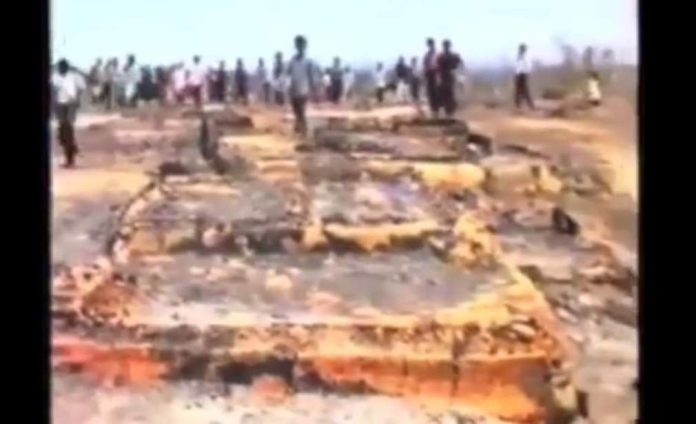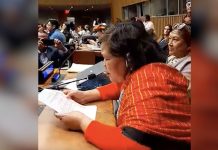Hill Voice, 10 April 2022, Special Correspondent: Today marks the 30th anniversary of the gruesome Logang genocide. This is one of the manifestations of barbarism against the indigenous Jummas in the Chittagong Hill Tracts. It was not just a genocide, on that day hundreds of Jumma houses were set on fire and destroyed. On this day in 1992, this brutal massacre and arson took place in Logang Jumma Cluster village of Panchari upazila under Khagrachari hill district of Chittagong.
The genocide took place with the joint conspiracy and participation of one of the state forces Bangladesh Rifles or BDR (now BGB) and Muslim Bengali settlers who had infiltrated in the Chittagong Hill Tracts. More than 200 Jumma villagers, including women and children were killed in the massacre, and more than 500 houses were set on fire, villagers said. However, the government acknowledged that 12 Jummas were killed, 13 were injured and two were missing. On the other hand. It admits that 550 houses were burnt to ashes..
After the incident, under national and international pressure, the government formed an inquiry committee headed by retired Justice Sultan Hossain Khan, but the government never exposed the full report of the committee to the public. There was no trial, no punishment for the culprits and no compensation for the victims. It may be mentioned that at the time of the incident it was Khaleda Zia-led BNP regime in the country . However, it was the military who was the de facto ruler of the Chittagong Hill Tracts.
According to a report prepared by Dr. Ramendu Shekhar Dewan, spokesperson of the Parbatya Chattagram Jana Samhati Samiti on March 21, 1993, the military forcibly relocated about 1500 Jumma families from nearby Jumma villages to the Logang cluster village, which is nothing but a concentration camp. The military, on the other hand, distributed the villages and lands of the Jumma’s ancestors to the infiltrating Bengali settlers for free. At this point, the military authorities hatched a conspiracy to drive the Jumma people out. On 10 April 1992, the military authorities sent two Bengali settlers with chopper and knives to rape some Jumma women who were grazing cows in a cluster villages. When the Bengalis tried to rape them, the Jumma women started shouting as protection to escape from them. Then a Jumma villager came and asked the Bengali settlers to release the Jumma women. But instead of leaving, the Bengali settlers attacked the Jumma villager and hacked him to death with sharp weapons. A Bengali settler was also slightly injured in the scuffle.
After killing that Jumma villager, the Bengali settlers went straight to the nearby BDR camp. At that time, the BDR authorities did not properly investigate the incident but instead used the incident of injuring a Bengali settler who was trying to rape as an opportunity to conspire. They started spreading propaganda that the Bengali settler was injured in a attack of the Shanti Bahini. Soon after, the military and Bengali settlers jointly attacked the Jumma’s Logang cluster village on the pretext of finding Shanti Bahini. During this time armed BDR members opened fire and Bengali settlers hacked the Jumma people with sharp weapons leaving many Jumma people killed and injured. According to eyewitnesses, the assaulter forced many Jumma women, children and the elderly person to enter into the houses and set the houses on fire killing many Jumma people alive. The Logang cluster village and many Jumma families in the vicinity were then forced to flee to the neighboring Indian state of Tripura. As always, the military authorities tried to cover up the Logang massacre as much as possible.
Even Khagrachari Cantonment Commander Brigadier Sharif Aziz prevented Khagrachari Hill District Local Government Council Chairman Samiran Dewan from visiting the spot on the day of the incident.
Coincidentally, a group of 23 people, including human rights activists, members of parliament, lawyers, journalists, professors, deputy attorney general and Western human rights activist Rosaline Costa, were on their way to Logang to attend the Jumma’s traditional social festival, Biju, Sangrai and Baisu. Army authorities also did not allow the traveling party to go to the scene. However, they were able to gather enough information from eyewitnesses, local authorities and military authorities.
According to the report of Dr. RS Dewan mentioned, according to the report of the traveling team, the drivers of the military trucks took the dead bodies and wounded persons to a secret place and burned them together. Survivor of the incident Baishishto Muni Chakma returned to Logang cluster on 11 April 1992 to claim his wife’s body, and he saw 39 bodies lying around his burnt house. But he was not allowed to remove his wife’s body for the funeral. On 11 April 1992, Samiran Dewan, Chairman of Khagrachari Hill District Local Government Council, was able to visit a small part of Logang village and count 139 bodies. He was then barred from visiting the rest of the village.
Based on the information received at the time, the 23-member visiting team issued a joint statement on 19 April 1992. They said in a statement that more than 400 houses were burnt down and more than 200 children, women and the elderly were killed. At the time, their statement helped the world learn about the Logang genocide. As a result, the government was unable to cover up the Logang massacre. It is learned that Subedar Habibur Rahman of BDR 24th Battalion, Naik Subedar Sarwar Hossain, local VDP commander Keramat Ali, VDP platoon commander Siddiqur Rahman, Ansar member Mohammad Noor Mia, Ansar member Habildar Jalil and Union Council Member Sirajul Islam, Logang Union Parishad Member Kazi Hanif, Logang Union Parishad Member Habib Ullah, Muslim Settler Mohammad Maqbool Mia, Muslim Settler Md. Idris Mia, Muslim Settler Sultan Kazi, Muslim Settler Mohammad Ilias, Muslim Settler Mohammad Mallya, Muslim Setler Jamal Khan, Muslim settler Mohammad Jamshed Bhuiyan directly led the massacre.
Needless to say, in the last 30 years, no government has taken the initiative to conduct an impartial investigation and for justice to this genocide like other genocides. These genocides are comparable to the genocide in Bangladesh in 1971 by the Pakistani aggressors. Although the Sheikh Hasina-led government ensured the trial and punishment of the Razakars who aided and abetted the genocide committed by the Pakistani aggressors as war criminals, this government also did not take any initiative to prosecute these brutal genocides against the Jumma people.
Needless to say, no government can and will avoid the responsibility for the trial of this genocide. It is certainly shameful and disgraceful for the government and the state that the government and the state have not yet been able to ensure its justice.




